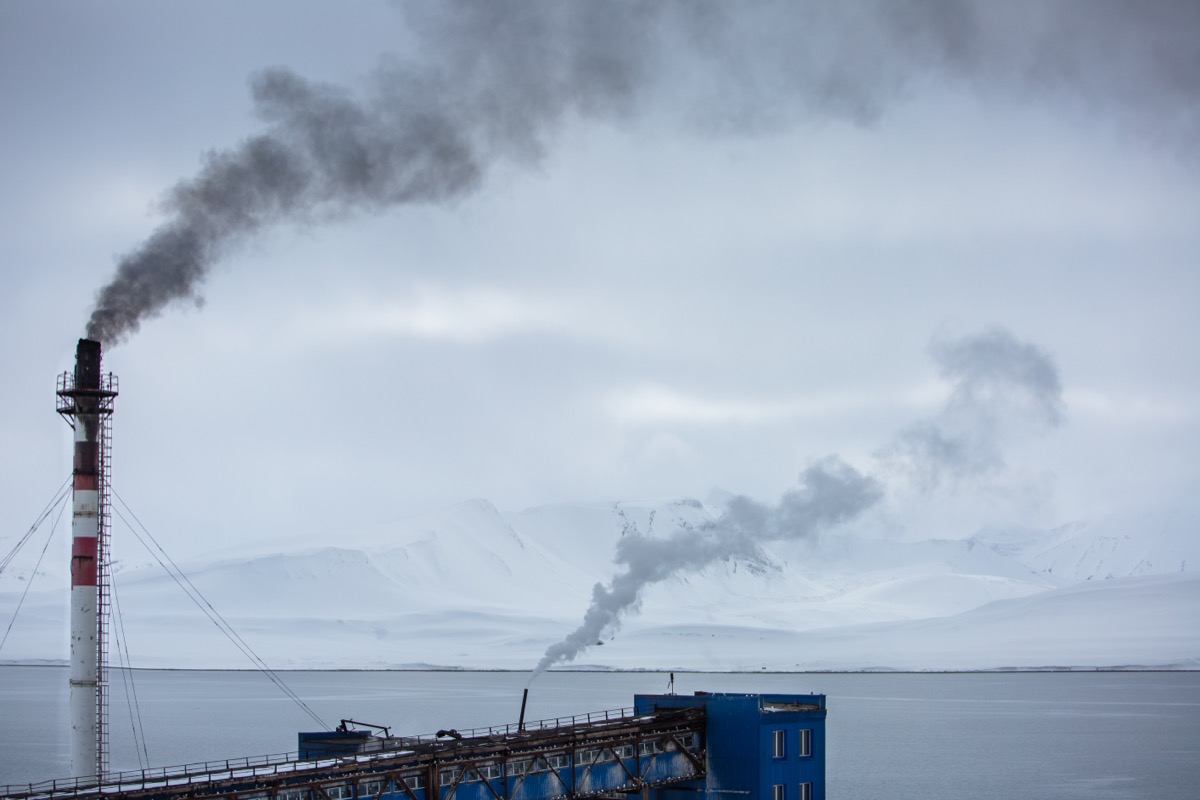The Norwegian archipelago of Svalbard is warming six times faster than the global average. Natural disasters threaten the inhabitants, while the local government makes efforts to limit the damage. “This place has always been the scene of discovery and exploitation. It is time to break that cycle.”
Church bells can be heard in the distance through the blow of the blizzard. A few parishioners laboriously slog their way through the meter-high snow towards the red wooden church of Longyearbyen, the northernmost city in the world located on the Norwegian Spitsbergen archipelago.
Liv Limstrand, the only cleric on the Norwegian archipelago of Spitsbergen, welcomes the churchgoers with a smile at the oak door of the building. Inside, they take off their snow boots, a tradition adopted from the miners.
Before the start of the mass, Limstrand, dressed in her white abbot, thanks those present for coming. The snowstorm, which has been raging for days and is causing a lot of inconvenience, has clearly played tricks on the turnout.
After the first hymn, the pastor asks to follow her in prayer: “We pray for our fragile earth, for all the creatures that are threatened when the ice melts, when the sea level rises and the weather becomes more and more extreme.” The churchgoers cross themselves, after which there is a deafening silence.
Every year the weather gets more extreme on Spitsbergen. The archipelago is warming six times faster than the global average. As a result, there is more precipitation in autumn and winter and storms are becoming more frequent and more intense. In summer, temperatures reach unprecedented heights.
In July 2020, Longyearbyen recorded a temperature of 21.7 degrees, breaking a 41-year record. Last summer it got even hotter. The inhabitants of Spitsbergen experience the consequences of climate change every day.
Church against climate change
Since its foundation in 1921, the church in Longyearbyen has always played an important role as a meeting place, both for religious services and cultural gatherings. Now the institution is emphatically taking a position in the fight against global warming.
Limstrand believes it is the role of the church to inform the residents of Longyearbyen. On tables in the seating area of the church are books about ‘the church where the ice melts’ and the multipurpose room of the building often serves as a meeting place for local climate activists.
“As humans, we are part of a mutual network,” says Limstrand, offering tea. “If we do not pay attention to nature, we sin. Man has an enormous responsibility.”
Every Sunday she urges her churchgoers to deal with nature in a responsible way. But of course that is not on Spitsbergen.
The 2,500 inhabitants of the remote archipelago have to be supplied by boat and ship. Transport on the island is mainly done by polluting snowmobiles and energy is generated by a polluting coal-fired power station.
Limstrand is therefore under no illusions. “The fact that we live here contributes to climate change. But change starts with insight.’
The relationship between man and nature on Spitsbergen has always been tense. After the discovery of the archipelago by the Dutchman Willem Barentsz, the fjords became a hunting ground for whale hunters. After all the whales were killed or driven out, trappers hunted polar bears.
At the end of the nineteenth century, coal was found in the steep mountain slopes of the island, after which American, Norwegian and Russian mining companies settled there. “This corner of the world has always been the scene of discovery and exploitation,” the pastor sighs. It’s time to break that cycle.

Church against climate change
Since its foundation in 1921, the church in Longyearbyen has always played an important role as a meeting place, both for religious services and cultural gatherings. Now the institution is emphatically taking a position in the fight against global warming.
Limstrand believes it is the role of the church to inform the residents of Longyearbyen. On tables in the seating area of the church are books about ‘the church where the ice melts’ and the multipurpose room of the building often serves as a meeting place for local climate activists.
“As humans, we are part of a mutual network,” says Limstrand, offering tea. “If we do not pay attention to nature, we sin. Man has an enormous responsibility.”
Every Sunday she urges her churchgoers to deal with nature in a responsible way. But of course that is not on Spitsbergen.
The 2,500 inhabitants of the remote archipelago have to be supplied by boat and ship. Transport on the island is mainly done by polluting snowmobiles and energy is generated by a polluting coal-fired power station.
Limstrand is therefore under no illusions. “The fact that we live here contributes to climate change. But change starts with insight.’
The relationship between man and nature on Spitsbergen has always been tense. After the discovery of the archipelago by the Dutchman Willem Barentsz, the fjords became a hunting ground for whale hunters. After all the whales were killed or driven out, trappers hunted polar bears.
At the end of the nineteenth century, coal was found in the steep mountain slopes of the island, after which American, Norwegian and Russian mining companies settled there. “This corner of the world has always been the scene of discovery and exploitation,” the pastor sighs. It’s time to break that cycle.
A race against time
Scientists have been exploring the Arctic for decades, but the work is becoming more urgent as climate change intensifies. Hundreds of researchers travel to the archipelago every year to rapidly collect data on melting glaciers, extreme precipitation, disappearing sea ice and endangered flora and fauna.
“Climate change is happening frighteningly fast here,” says British microbiologist Arwyn Edwards. He takes us to the Foxfonna Glacier 15 kilometers from the city.
While students from the university take samples from the ice, he shows a photo of the glacier from 2006. “I took this photo when I started here,” he says nostalgically. The difference with the current situation is enormous.
“The glaciers on Spitsbergen are melting at an average of 0.6 meters per year, but the trend is accelerating,” Edwards explains. Last summer, 44 gigatons of meltwater disappeared into the ocean, enough to fill 53 million Olympic swimming pools.
Glaciers make up 60% of the Spitsbergen landscape and are melting 3.5 times faster than glaciers in Greenland and Antarctica. This is the result of past climate change, the scientist emphasizes. Glacier retreat occurs with a delay of years or decades, depending on its size.
“But even if we could stop global warming now and here, the glaciers will continue to melt,” he sighs. With the current warming, they will melt by 1 meter per year by 2100. “By then most of the glaciers will be lost.”
The clock is therefore ticking mercilessly for the scientists on Spitsbergen. “We are rapidly losing these environments and therefore need to collect data at a rapid pace.”
The scientist admits that he sometimes loses courage. The current global climate policy will not be enough to turn the tide. “We still have eight years to protect the ecology of sea ice. That’s 400 weeks. Action must be taken now.”
Scientific studies prove the microbiologist right. The Climate in Svalbard 2100 report, commissioned by the Norwegian Environment Agency, paints a grim picture of the archipelago’s future if current trends continue.
The loss of glaciers on Spitsbergen alone will contribute about two centimeters to global sea level rise by 2100. “That doesn’t seem like much, but in climatology we use the rule of thumb that one centimeter of sea level rise means one million people will have to move,” says Edwards. The increase also brings a lot of side effects, such as coastal erosion and storm surges.
“What is happening at a rapid pace here on Spitsbergen does not bode well for Greenland and Antarctica either,” the Briton warns. There, melting glaciers could cause a sea level rise of 20 centimeters and 1 meter respectively in 2100. All together, a rise of 1 to 2 meters is expected.

A matter of money, concrete and steel
On Spitsbergen, the consequences of rapid global warming are increasingly visible. Longyearbyen Bay has been ice-free for years and the extreme weather is bringing climate change dangerously close to residents.
Warmer temperatures lead to unstable snow cover, making avalanches more frequent. In 2015, eleven houses were buried under a snow avalanche, something that had never happened before in the village. Two people were killed, including a five-year-old toddler, and dozens were injured.
Even now, the streets at the foot of a steep mountain wall have been closed for several days as a precaution. “That was unthinkable ten years ago,” says a passerby, before walking past the prohibition sign and continuing his walk undisturbed.
“We can no longer take risks,” said Arild Olsen, the mayor of Longyearbyen. The former miner had been mayor for two months when the avalanche hit. “I can still hear the groans of the wounded under the snow. That does something to you.”
Miraculously, Olsen’s house was not hit, his neighbors were less fortunate. Two years later, the town was hit again, with another six houses disappearing under the snow.
The mayor is now making climate change priority number 1. A crisis center monitors the situation, irregularities are mapped out and residents are sensitized. “We have to do everything we can here to protect the community from natural disasters. And unfortunately they are becoming more frequent as the climate changes.”
The mayor seems combative. In his office there are maps of the island on every wall. On his desk are plans for major infrastructure works. “Protecting the people here is a matter of money, concrete and steel,” he says confidently. ‘It is possible.’
The mayor seems to be taking action. The mountains around Longyearbyen were equipped with steel structures last year to break the avalanches. The banks of the river, which erodes more and more in summer, are strengthened. The foundations of houses, which threaten to subside due to the thawing permafrost, are also placed on steel piles.
These interventions are welcomed with applause by the residents of Longyearbyen. “The board is taking very decisive measures to protect the residents,” says Oddgeir Sagerup with conviction.
The teacher was forced to move after the disaster of 2015. The damage to his home was all in all limited, but after investigation it turned out to be in a danger zone. Now he lives with his family in the center of Longyearbyen, far away from the mountain slopes. “After the avalanche, many children no longer dared to go to school. Some parents even kept their offspring indoors for days.”
The snow barriers and reinforcements provide a sense of security, according to Sagerup. Nevertheless, he is worried about Spitsbergen’s future. “I hold my breath for what the coming years will bring. I take into account that we will have to move to the mainland due to climate change.’
The end of coal
The municipality and the Norwegian government are taking decisive measures in the hope of limiting climate change on Spitsbergen. By 2030, CO2 emissions must be reduced by 80% and energy consumption must be reduced by 30%.
Large, polluting cruise ships are no longer allowed to dock and the number of tourists on the island is limited. Hollywood stars such as Tom Cruise, who recently submitted an application to film on Spitsbergen, receive no response.
Longyearbyen’s power station will switch from coal to diesel this year, to be completely replaced by greener alternatives later. The mining company Store Norske therefore decided to close the last active mine in Spitsbergen, Gruve 7, in 2025.
And that is a sensitive issue in a city with a mining past. “A long tradition is fading,” says foreman Bent Jakobsen as he takes a sip from his beer. During our meeting in the miners’ bar, he finds it hard to hide his disappointment with the policy. “We are the last miners. That makes me sad.”
Jakobsen remembers the rhythmic rattle of the coal carts that rode the cable cars through the city every day. Now the towers are languishing as nature once again takes over the area. Herds of reindeer dig through the snow at the foundations, looking for moss and grass.
Jakobsen says that his entire family worked in the mines. Coal is in my blood. For Jakobsen, the closure is a difficult pill to swallow. After almost twenty years of service, Jakobsen is now responsible for the clearance. “The mines have ensured that everyone here had electricity and heat for the last hundred years. And now they are abandoning us.”
Despite the enormous changes on Spitsbergen, Jakobsen is very skeptical about climate change and government policy. “I don’t think human activities are changing the climate much,” he says without batting an eyelid. The miner is not convinced that the closure will make a big difference. “The world just needs coal. Does it not come from here, or from somewhere else. Why not do it as safely and cleanly as possible?’, he asks rhetorically.

The only way forward
“It is important to acknowledge the pain of the miners,” says Limstrand. The pastor provides mental guidance in the transition to a more green future.
There are no psychologists or therapists on Spitsbergen, which makes it difficult for the miners to place their feelings and frustrations. “They sacrificed their bodies for years and their colleagues died deep in the mountains. And suddenly you’re worthless. That’s difficult.’
At the same time, Limstrand is convinced that closing the mines is the only way forward. “Everyone here has known for years that the mines no longer have a future. But we have to make sure that we take the step with everyone in the transition to green energy.’
The reverend takes us to the cemetery of Longyearbyen. Twenty white crosses protrude from the snow, in the background a steep mountain towers above us.
Six years ago, due to sudden changes in temperature and increased precipitation, part of the mountain side came down. The landslide threatened to drag the graves with it. “Everything came down. The mine’s old funiculars collapsed. But miraculously, the cemetery was spared,’ says Limstrand.
She points to the gorges on either side of the cemetery, which are still clearly visible. “Here you see the wounds of the earth. You see the consequences of climate change.”
She pauses for a moment, turns to look at the city in the distance. “We can’t help but leave the past behind. Otherwise we have no future here.”
This report was realized with the support of Journalismfund.



